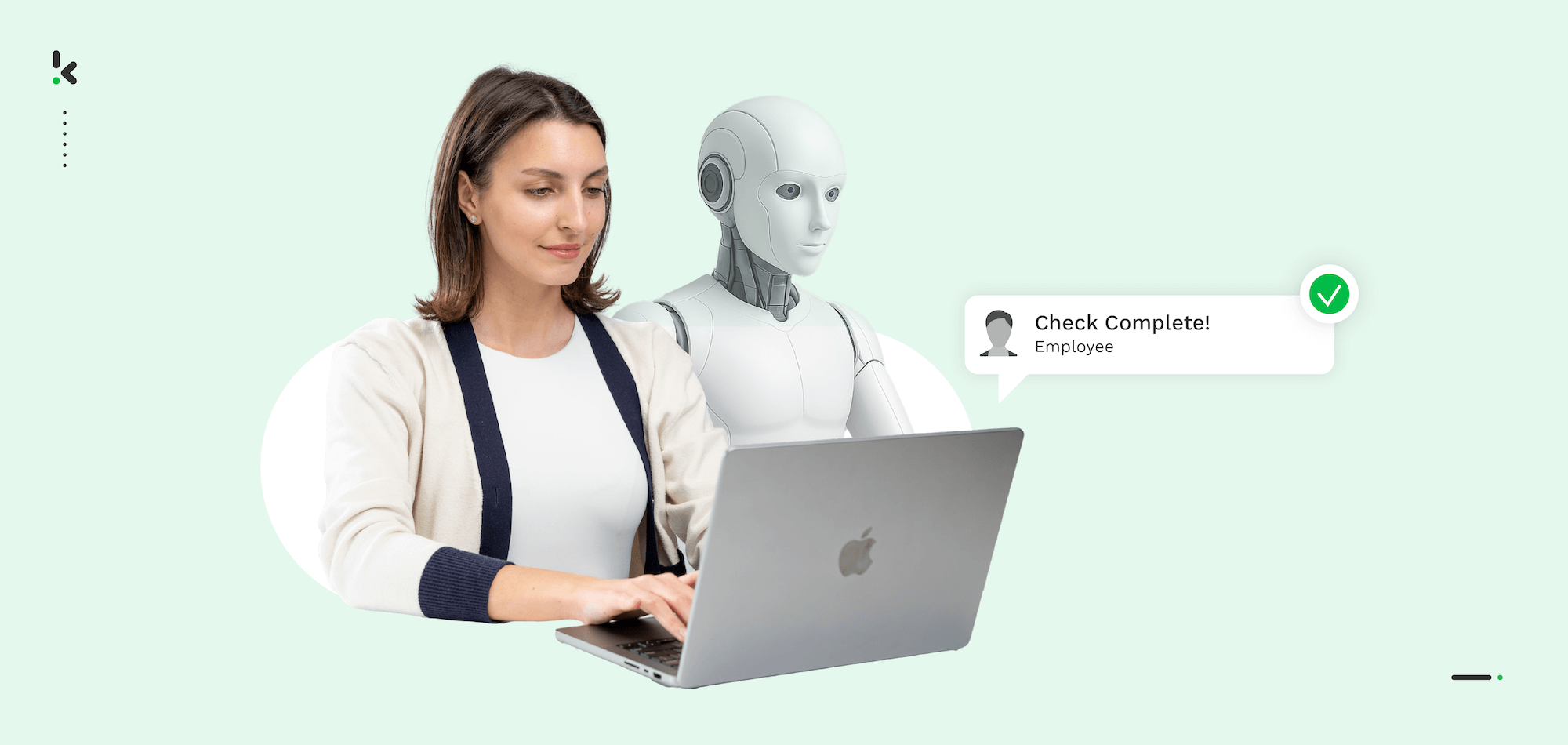

AI is everywhere right now, and for a good reason. It’s helping teams move faster, work smarter, and spend less time on boring, repetitive tasks. In Klippa’s research on The State of Professional Perceptions on AI, 40% of employees said AI gave them more time to focus on creative or strategic work. That’s a big win.
But let’s be real: AI doesn’t always get it right. Especially when the data is messy or the task is tricky. And when mistakes happen, they can be expensive.
Take data extraction, for example. OCR software might hit 97% accuracy on a good day, but in industries like finance or healthcare, even a 1% error can cost you millions.
That’s where Human-in-the-Loop (HITL) automation comes in.
By combining AI with human checks at important steps, HITL helps you hit higher accuracy, reduce risk, and make smarter decisions – without losing speed.
In this guide, we’ll break down what HITL is, how it works, when to use it, and how businesses like yours are already using it to get better results.
Let’s dive in.
Key Takeaways
Here’s what you’ll learn in this article:
- AI isn’t perfect and that’s okay. HITL helps catch what automation alone can miss, especially with complex, messy, or high-stakes data.
- You can start small or scale big. Whether you’re training a model from scratch or validating outputs, HITL works at any stage of automation.
- You have flexible setup options. Choose between self-managed or externally managed HITL depending on your resources and data privacy needs.
- Use cases are everywhere. From invoice processing to KYC, HITL adds value wherever accuracy matters.
To help you decide which workflow is right for you, we’ve included a comparison table below showing how manual, automated, and HITL-powered processes compare.


Why Automation Alone Isn’t Enough
Manual workflows take time, cost money, and leave a lot of room for mistakes. Think of a typical document process:
Someone scans a file, another enters the data, and someone else double-checks it – over and over again.
It works… until it doesn’t.
When document volume spikes or accuracy becomes critical, this kind of setup just can’t keep up. It’s slow, expensive, and hard to scale.
That’s why many companies turn to automation. Tools like Intelligent Document Processing (IDP) can handle things like scanning, extracting, sorting, and validating data – all much faster than a human.
Sounds perfect, right? Almost.
While IDP can handle a lot, it’s not flawless. Poor-quality files or complex documents can throw it off. One wrong number, like reading €100,000 instead of €10,000, can have serious consequences.
That’s the downside of going fully hands-off with automation. When things go wrong, there’s often no one there to catch it.
This is where Human-in-the-Loop (HITL) comes in. It’s that safety net between speed and accuracy, letting AI do the heavy lifting while humans jump in when it really matters.
So what exactly is Human-in-the-Loop, and how does it actually work in real workflows?
What is Human-in-the-Loop?
To put it simply, Human-in-the-Loop (HITL) is when a human steps in to help an AI system make better decisions. It means the AI does most of the work, but a person checks, fixes, or approves results when needed.
Here’s a simple example: At the supermarket, self-checkout machines let you scan and pay by yourself. But there’s usually a staff member nearby. That person helps if something goes wrong. That’s Human-in-the-Loop.
In automation, HITL works the same way. The AI handles most of the tasks, and a human steps in when the system isn’t confident or needs help.
This makes the process more accurate and helps avoid costly mistakes.
Next, let’s see how it works in AI systems.
How Human-in-the-Loop Works in AI
AI has come a long way, but it’s not perfect. And it likely never will be. Data changes, business needs shift, and not everything can be predicted. That’s exactly why Human-in-the-Loop (HITL) is so important.
So how does HITL work in AI? Let’s say you want to train an AI model to recognize shapes like circles, squares, and triangles. First, a human labels a bunch of images correctly. These labels help the AI learn what each shape looks like.
Over time, the AI gets better at making predictions. But when it gets something wrong, a human steps in, fixes it, and feeds that correction back into the system. This process is called a feedback loop, and it’s what helps the model improve.


The same idea applies to tasks like data extraction.
OCR tools might promise up to 97% accuracy (in ideal cases), but most off-the-shelf solutions average around 80%. That remaining 20%? It’s often where the costly mistakes happen – especially if you’re dealing with financial data, IDs, or sensitive documents.
That’s the gap HITL fills.
With humans in the loop, you can:
- Catch and fix AI errors in real time
- Train models with higher-quality data
- Improve accuracy continuously
This process is often called HITL annotation or data labeling, and it’s a key part of how modern AI models are developed.
Human-in-the-Loop Annotation
HITL annotation is when a person manually labels data, like highlighting key fields in a receipt or tagging items in an image. These labeled examples help AI models understand what to look for.
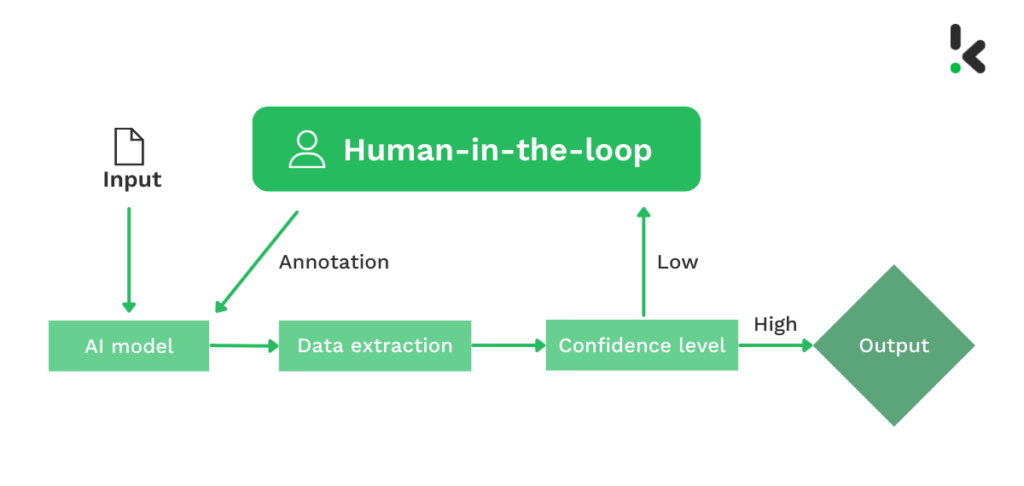

The better the data, the better the AI.
For example, if your team wants to train a model to extract line items from receipts, you’ll likely need thousands of receipts labeled by hand before the AI can do it well on its own.
This takes time, effort, and expertise, but the payoff is real. You end up with a system that’s accurate, reliable, and tailored to your needs.
So, why go through all this effort when some tools offer “97% accuracy” out of the box?
That’s what we’ll explore in the next section.
Benefits of Human-in-the-Loop Automation
Why do we still need humans in the loop? Because even the best automation can still fall short. Just like manual processes, fully automated systems aren’t flawless. Mistakes still happen, and in some cases, they’re expensive. That’s exactly why human involvement still matters.
Humans are naturally better at recognizing patterns, dealing with ambiguity, and making decisions with limited information. Think of how you can recognize a tiger just by seeing its tail. For AI, that kind of recognition takes thousands of examples and fine-tuning. Human-in-the-Loop (HITL) helps bridge the gap between automation and accuracy.
Below are the key benefits of using HITL in your workflows:
There are various benefits to leveraging HITL to train AI models or improve workflows, which include:
1. Better Accuracy Across the Board
With HITL, humans step in to review, correct, or validate AI outputs. This leads to higher accuracy in tasks like data extraction, prediction, classification, and validation, especially when AI confidence is low.
2. Handles Complex or Unseen Data
AI struggles with edge cases or unfamiliar data. Humans can interpret these exceptions and help the model learn how to deal with them next time. HITL makes your AI more adaptable in the long run.
3. Improves Over Time Through Feedback
HITL creates a continuous feedback loop. Every correction a human makes helps improve the algorithm, leading to smarter, more accurate AI with less manual work over time.
4. Not Limited by Training Data Quality
Most AI models rely heavily on the data they were trained on. But real-world data is often messy or inconsistent. Human input fills in those gaps, helping the system function even when the training data falls short.
5. Saves Developer Time
Developers don’t have to spend hours reviewing low-confidence outputs or building overly complex rules. With HITL, humans handle the edge cases so your team can focus on higher-level development.
6. Works Better With Incomplete Data
Some datasets will always have missing or unclear fields. HITL enables the system to handle incomplete or tricky data more efficiently, reducing the chance of errors slipping through.
In short, HITL makes your automation smarter, safer, and more reliable without sacrificing speed.
However, there are some limitations to keep in mind as well, which we cover next.
Limitations of the HITL Approach
Even though Human-in-the-Loop automation combines the best of human intelligence and artificial intelligence, it has some limitations. These limitations include:
1. Defining Human Roles
You’ll need to clearly define who does what in the loop. That means assigning people to specific interfaces, tasks, or review points, especially in complex workflows.
2. Handling Large Volumes
HITL can struggle with high-volume workloads. The more data you process, the more human input you need, making it harder to keep up without a well-planned structure.
3. Limited Scalability
Unlike pure automation, HITL doesn’t scale infinitely. Adding people to a process can slow things down if not managed efficiently.
That said, these challenges are often far smaller than the risks of going fully manual or fully automated. With the right setup, HITL can still offer high accuracy, efficiency, and peace of mind.
When to Implement Human-in-the-Loop
Not sure when to leverage human-in-the-loop within your workflows? No problem. We’ve got you covered. In our experience, it makes the most sense to have a human in the loop at the beginning or the end of a loop, depending on your goals.
Let’s break it down:
Human at the Beginning of the Loop
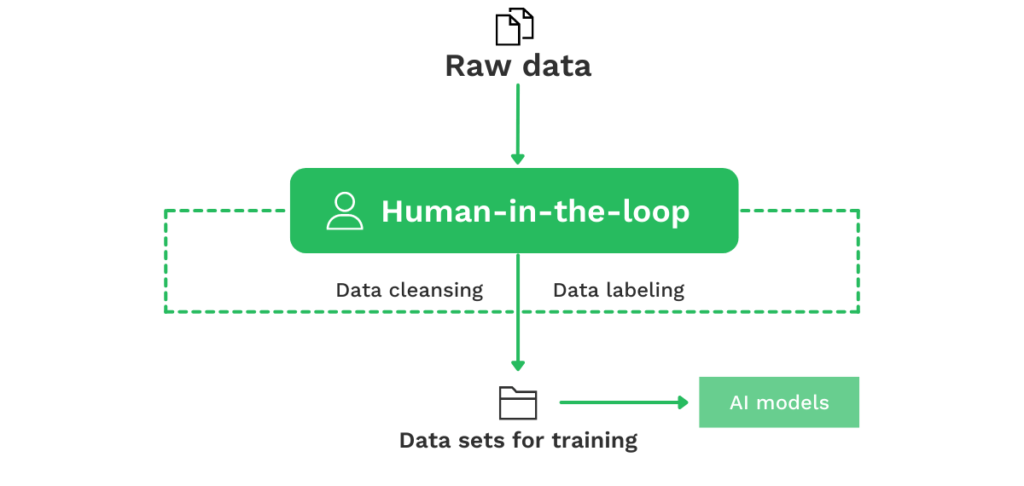

If you’re just starting out with AI – or don’t have much automation in place – putting a human at the start helps you train the model from scratch.
Humans can clean and label raw data so the AI learns what to look for.
Use this approach when:
- You’re building your own datasets
- You want to train a new AI model
- You have little to no automation yet
- You have in-house data labelers or AI experts
Real-life example:
Facebook used HITL to improve its facial recognition tool, DeepFace. Users confirmed or rejected suggested photo tags, helping train the algorithm. This is HITL at the beginning – using real user input to build and refine the model.
This method helps you go from 0% automation to 80% or more over time.
Human at the End of the Loop
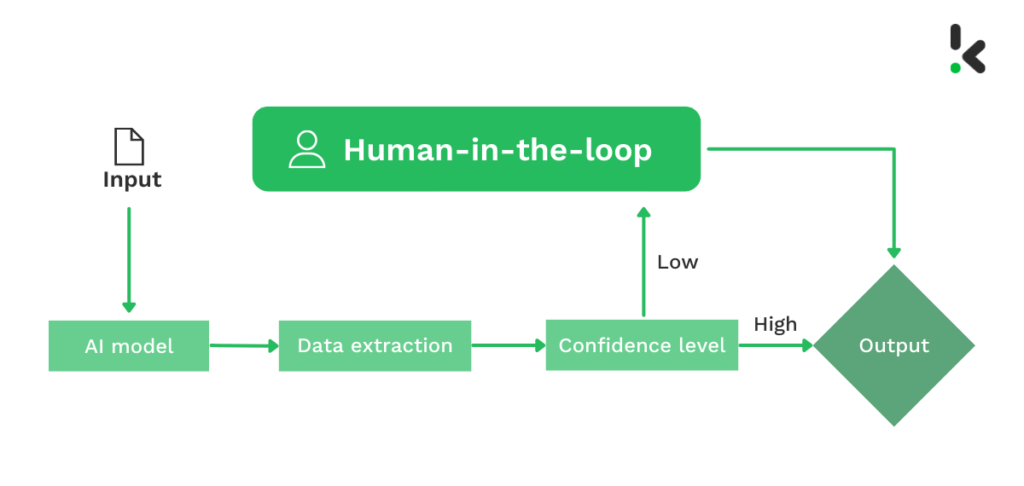

In more mature workflows, it’s common to let automation handle most tasks – then bring in humans to check, validate, or correct the results.
This ensures high accuracy without needing constant manual effort.
Use this approach when:
- You want to reach near 100% accuracy
- You’re automating at scale but still want human checks
- You want to catch errors before they become costly
- You need to improve turnaround time without sacrificing quality
Using human-in-the-loop at the end of a loop is more common in many business cases. This approach leverages automation to do repetitive tasks and human intelligence to ensure that everything runs correctly.
Real-life example:
Coca-Cola’s MyCokeRewards app used OCR to read bottle cap codes. When confidence was low, users were asked to confirm or correct the characters. This feedback helped improve the system over time – an example of HITL at the end of the loop.
Choosing the Right HITL Setup: External vs. Self-Managed
Sometimes, involving end-users in your HITL process, like Facebook or Coca-Cola did, isn’t an option. Maybe it’s due to privacy concerns, technical limits, or simply how your business works.
In that case, you have two main paths forward:
- Externally managed HITL
- Self-managed HITL
Each approach has its pros and cons, especially when it comes to cost, control, and data privacy. Let’s break them down.
1. Externally Managed HITL
This means a third party (like a SaaS provider or data annotation service) handles the human-in-the-loop part for you.
Pros:
- Can deal with high peak volumes of data
- Fast and often comes with 24/7 availability
- Cheaper because the experts know what they are doing
- No need to dedicate time to training staff
Cons:
- Data goes to the external party
- Security measures may depend on the external party
- Regulatory compliance concerns
2. Self-Managed HITL
This approach keeps everything in-house. Your own team manages the loop and performs annotations or validations.
Pros:
- Full control – data stays within your infrastructure
- Better for privacy and compliance
- Great for building internal knowledge and custom datasets
Cons:
- Requires a team of experts
- It can become costly with training and implementation
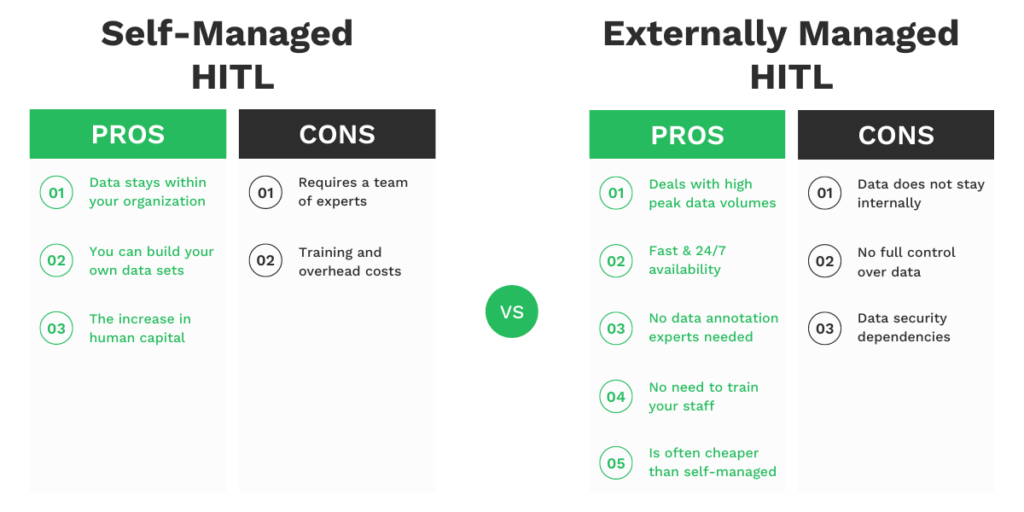

So, which one should you choose?
It comes down to your priorities:
Do you need speed and scale, or is data control and compliance more important?
The right approach depends on your use case, your resources, and how critical data security is to your business.
Common Use Cases for HITL Automation
Human-in-the-Loop automation isn’t limited to one type of task – it’s helpful wherever accuracy matters and automation alone doesn’t cut it.
Some of the most common use cases we see include:
- Receipt processing for loyalty campaigns
- Invoice processing for accounts payable
- Anonymizing sensitive data for compliance
- ID card verification for KYC processes
Don’t see your exact use case listed? No worries, these are just a few examples. Let’s walk through each one to show how HITL can make a real difference in day-to-day operations.
1. Receipt Processing for Loyalty Campaigns
In loyalty programs, customers submit receipts to earn rewards. AI can handle scanning, extracting product info, and validating purchase dates – but it’s not perfect.
Scanned receipts often vary in layout, language, or quality. If the AI isn’t confident (e.g., score below 70%), the receipt is flagged and passed to a human for review. This helps catch errors, prevent fraud, and ensure rewards go to the right customers.
With HITL in place, businesses can:
- Reduce manual review time
- Increase data accuracy
- Prevent missed or incorrect rewards
- Handle thousands of receipts daily without burning out the team
Read more about this topic in our full Receipt Scanning for Loyalty Campaigns article.
2. Invoice Processing for Accounts Payable
Invoices come in all shapes and formats, making 100% automation tough. AI can extract key fields, like amounts, due dates, and vendor info, but when fields are missing, handwritten, or placed inconsistently, errors happen.
HITL ensures that low-confidence extractions are corrected before they enter your financial system, reducing the risk of overpayments, delays, or duplicate entries.
Read our article on invoice processing for more details.
3. Anonymization of Sensitive Data
When sharing documents externally, whether for legal, medical, or customer support purposes, personally identifiable information (PII) must be removed.
AI can identify and redact standard patterns (like email addresses or ID numbers), but it may miss edge cases. HITL adds a layer of review, helping ensure full compliance with regulations like GDPR and HIPAA.
Read our guide on data anonymization for more details.
4. ID Card Verification for KYC
KYC processes often rely on identity documents like passports or driver’s licenses. AI can extract and validate this data quickly, but if the photo is blurry, the document is damaged, or the format is unfamiliar, confidence drops.
HITL allows a human to step in and verify the data or flag fraudulent documents, keeping your onboarding process smooth, but secure.
Learn more about ID card verification here.
How to Get Started with HITL Automation
Before diving into vendors or tech solutions, it’s worth pausing to think about what you really need. Ask yourself:
- Do we need near-100% accuracy for data extraction?
- Is it more important to keep data in-house, or are we open to external providers?
- Do we have in-house AI expertise – or will we need external support?
- Are we looking to build our own datasets and train custom models?
- What are the must-haves for our specific use case?
These questions will help you decide whether to go with a fully managed HITL solution, build something internally, or find a mix of both.
Need help figuring out the cost impact? We’ve put together a free cost savings calculator to compare fully automated vs. HITL-enhanced workflows so you can make the right call based on your goals and budget.
Automate Smarter with Klippa’s HITL-Ready Solutions
At Klippa, we specialize in helping businesses automate document-heavy workflows – whether you’re just starting with automation or looking to fine-tune an existing process with Human-in-the-Loop (HITL) support.
Our platform, Klippa DocHorizon, combines powerful AI-driven OCR with features like data extraction, classification, document conversion, anonymization, and verification. You can automate end-to-end workflows – or choose to keep a human in the loop for extra peace of mind where it matters most.
Easy to Integrate, Easy to Scale
Already have your own system? Great. Klippa integrates easily via API for web applications, and we also offer a mobile SDK for scanning on the go. And yes, HITL support plugs right into all of it.
Built-In HITL Interface (So You Don’t Have to Build One)
Creating your own validation interface can be time-consuming and expensive. That’s why we provide a ready-to-use HITL interface – fully integrated and easy to deploy.
Use it to:
- Validate and correct low-confidence results
- Flag specific document types or suppliers
- Annotate data to train your AI models
- Let your team verify or label results within seconds
Whether you prefer to manage HITL in-house or lean on Klippa’s expert back office team, we’ve got you covered. HITL doesn’t just boost accuracy. It saves time, reduces costs, and gives you more control over your automation journey.
Curious how this could work for your use case?
Book a demo below to get you started or contact our team of experts if you have any additional questions – we’re happy to show you what’s possible!
FAQ
Human-in-the-Loop (HITL) automation is a workflow where AI handles most of the work, but a human steps in at key moments to review, correct, or guide the system – especially when confidence is low or accuracy is critical.
Use HITL when you’re dealing with sensitive data, complex documents, or tasks where mistakes can be costly – like invoice processing, KYC, or compliance-related work. It’s ideal when you need high accuracy without fully relying on manual labor.
Yes. With platforms like Klippa DocHorizon, HITL can be added to your existing workflows via API or SDK. Whether you have a web app or mobile app, HITL can plug in seamlessly to handle exceptions and validate low-confidence results.
Self-managed HITL means your team handles the human review process in-house. Externally managed HITL involves outsourcing that work to a trusted provider. The right choice depends on your internal resources, data privacy needs, and scalability goals.
Each human correction creates a feedback loop that trains and improves your AI model. Over time, this makes the system more accurate, reducing the need for human intervention in the long run.